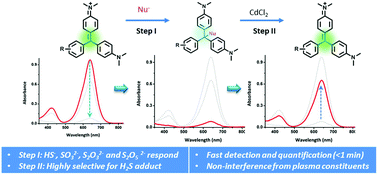Electronically-tuned triarylmethine scaffolds for fast and continuous monitoring of H2S levels in biological samples†
Abstract
A sensor for the detection and quantification of H2S in biological samples should ideally meet a set of criteria such as fast detection, high sensitivity in the desired concentration range, high selectivity, non-interference from biomolecules like proteins, ease of synthesis, long-term stability and water solubility. Although a number of H2S probes are known, none of them possess all the above attributes that are relevant for practical applications. As part of a program to develop reliable chemical probes for continuous monitoring of this gasotransmitter in the blood plasma of sepsis-prone individuals in post-operative wards, we have looked at the possibility of improving the reactivity and selectivity profile of triarylmethine dyes towards different nucleophiles. After achieving high sensitivity through electronic control, the interference from sulfite, thiosulfate and metabisulfite was addressed by introducing a metal salt-mediated desulfuration step that results in dye regeneration selectively from its H2S adduct. Typically, if the analyte contains only H2S, the loss of absorbance in the first step gets completely reinstated after the second step; absorbance changes in both steps vary linearly with sulfide concentration and either of these two steps can be used for the quantification of H2S with the help of standard plots. In the presence of interfering ions, the first step will show decolourization due to the presence of all of them whereas only the H2S-adduct will undergo desulfuration in the second step which can be used for quantification. The decolourization step is instantaneous while the desulfuration requires only about 50 s, making the entire protocol complete in less than a minute. The methodology optimized here also meets the requirements mentioned above for real-life applications.

- This article is part of the themed collection: Analyst Recent HOT articles


 Please wait while we load your content...
Please wait while we load your content...